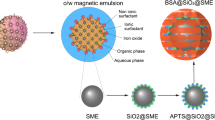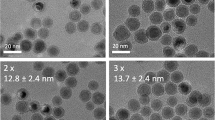Abstract
Hydrophilic magnetic nanoparticles present many interest for various medical applications due to their unique properties: immunoassays, imaging and hyperthermia. With regards to their applicability in the biomedical field, colloidal stability is a key parameter related to nanoparticle surface functionalization. In this paper, we report the water transfer of hydrophobic oleic acid coated iron oxide nanoparticles comparing two methodologies to obtain water dispersible iron oxide nanoparticles: exchange ligands with small strong chelating agent (caffeic acid) and SiO2 shell passivation. Both strategies are leading to stable aqueous ferrofluid but differing by their interactions. The non linear magnetic behavior at high and low magnetic field and second derivative signature of water dispersed superparamagnetic Fe304 nanoparticles samples are studied using conventional SQUID equipment and miniaturized detector MIAplex® device. We demonstrated those samples differing only by their interparticle interactions present different magnetic behavior at very low magnetic field whereas at high magnetic field both samples are very similar.




Similar content being viewed by others
References
Chi X, Huang D, Zhao Z, Zhou Z, Yin Z, Gao J (2011) Nanoprobes for in vitro diagnostics of cancer and infectious diseases. Biomaterials 33:189–206
Koh I, Josephson L (2009) Magnetic nanoparticle sensors. Sensors 9:8130–8145
Tamanaha CR, Mulvaney SP, Rife JC, Whitman LJ (2008) Magnetic labeling, detection, and system integration. Biosens Bioelectron 24:1–13
Marquette CA, Blum LCJ (2006) State of the art and recent advances in immunoanalytical systems. Biosens Bioelectron 21:1424–1433
Graham DL, Ferreira HA, Freitas PP (2004) Magnetoresistive-based biosensors and biochips. Trends Biotechnol 22:455–462
Megens M, Prins M (2005) Magnetic biochips: a new option for sensitive diagnostics. J Magn Magn Mater 293:702–708
Wei S, Wang Q, Zhu J, Sun L, Lin H, Guo Z (2011) Multifunctional composite core-shell nanoparticles. Nanoscale 3: 4474–4502
de Montferrand C, Lalatonne Y, Bonnin D, Lièvre N, Lecouvey M, Monod P, Russier V, Motte L (2012) Size-dependent nonlinear weak-field magnetic behavior of maghemite nanoparticles. Small 8:1945–1956
de Montferrand C, Lalatonne Y, Bonnin D, Motte L, Monod P (2012) Non-linear magnetic behavior around zero field of an assembly of superparamagnetic nanoparticles. Analyst 137:2304–2308
Lalatonne Y, Benyettou F, Bonnin D, Lièvre N, Monod P, Lecouvey M, Weinmann P, Motte L (2009) Characterization of magnetic labels for bioassays. J Magn Magn Mater 321:1653–1657
Massart R (1981) Preparation of aqueous magnetic liquids in alkaline and acidic media. Magn IEEE Trans on 17:1247–1248
Zhu Y, Wu Q (1999) Synthesis of magnetite nanoparticles by precipitation with forced mixing. J Nanopart Res 1:393–396
Qu S, Yang H, Ren D, Kan S, Zou G, Li D, Li M (1999) Magnetite nanoparticles prepared by precipitation from partially reduced ferric chloride aqueous solutions. J Colloid Interface Sci 215:190–192
Mascolo M, Pei Y, Ring T (2013) Room temperature co-precipitation synthesis of magnetite nanoparticles in a large ph window with different bases. Materials 6:5549–5567
Rockenberger J, Scher EC, Alivisatos AP (1999) A new nonhydrolytic single-precursor approach to surfactant-capped nanocrystals of transition metal oxides. J Am Chem Soc 121:11595–11596
Hyeon T, Lee SS, Park J, Chung Y, Na HB (2001) Synthesis of highly crystalline and monodisperse maghemite nanocrystallites without a size-selection process. J Am Chem Soc 123:12798–12801
Park J, An K, Hwang Y, Park J-G, Noh H-J, Kim J-Y, Park J-H, Hwang N-M, Hyeon T (2004) Ultra-large-scale syntheses of monodisperse nanocrystals. Nat Mater 3:891–895
Yu WW, Falkner JC, Yavuz CT, Colvin VL (2004) Synthesis of monodisperse iron oxide nanocrystals by thermal decomposition of iron carboxylate salts. Chem Commun 2306–2307. 10.1039/b409601k
Amstad E, Gillich T, Bilecka I, Textor M, Reimhult E (2009) Ultrastable iron oxide nanoparticle colloidal suspensions using dispersants with catechol-derived anchor groups. Nano Lett 9:4042–4048
Basti H, Ben Tahar L, Smiri LS, Herbst F, Vaulay MJ, Chau F, Ammar S, Benderbous S (2010) Catechol derivatives-coated Fe3O4 and γ-Fe2O3 nanoparticles as potential MRI contrast agents. J Colloid Interface Sci 341:248–254
Xue X, Wang F, Liu X (2011) Emerging functional nanomaterials for therapeutics. J Mater Chem 21:13107–13127
Karimi A, Denizot B, Hindré F, Filmon R, Greneche J-M, Laurent S, Daou T, Begin-Colin S, Le Jeune J-J (2010) Effect of chain length and electrical charge on properties of ammonium-bearing bisphosphonate-coated superparamagnetic iron oxide nanoparticles: formulation and physicochemical studies. J Nanopart Res 12:1239–1248
Lalatonne Y, Paris C, Serfaty JM, Weinmann P, Lecouvey M, Motte L (2008) Bis-phosphonates-ultra small superparamagnetic iron oxide nanoparticles: a platform towards diagnosis and therapy. Chem Commun 22:2553–2555
Motte L, Benyettou F, de Beaucorps C, Lecouvey M, Milesovic I, Lalatonne Y (2010) Multimodal superparamagnetic nanoplatform for clinical applications: immunoassays, imaging & therapy. Faraday Discuss 149:211–225
Guenin E, Hardouin J, Lalatonne Y, Motte L Bivalent alkyne-bisphosphonate as clickable and solid anchor to elaborate multifunctional iron oxide nanoparticles with microwave enhancement. J Nanopart Res 14:10
Ming Z, Brian LC, Charles JOC (2008) Synthesis and characterization of monodisperse ultra-thin silica-coated magnetic nanoparticles. Nanotechnology 19:085601
Lee J, Lee Y, Youn JK, Na HB, Yu T, Kim H, Lee S-M, Koo Y-M, Kwak JH, Park HG, Chang HN, Hwang M, Park J-G, Kim J, Hyeon T (2008) Simple synthesis of functionalized superparamagnetic magnetite/silica core/shell nanoparticles and their application as magnetically separable high-performance biocatalysts. Small 4:143–152
Chen DX, Sanchez A, Taboada E, Roig A, Sun N, Gu HC (2009) Size determination of superparamagnetic nanoparticles from magnetization curve. J Appl Phys 105:083924
de Montferrand C, Hu L, Milosevic I, Russier V, Bonnin D, Motte L, Brioude A, Lalatonne Y (2013) Iron oxide nanoparticles with sizes, shapes and compositions resulting in different magnetization signatures as potential labels for multiparametric detection. Acta Biomater 9:6150–6157
Hu L, de Montferrand C, Lalatonne Y, Motte L, Brioude A (2011) Effect of cobalt doping concentration on the crystalline structure and magnetic properties of monodisperse CoxFe3-xO4 nanoparticles within nonpolar and aqueous solvents. J Phys Chem C 116:4349–4355
Caizer C (2003) Saturation magnetization of g-Fe2O3 nanoparticles dispersed in a silica matrix. Physica B Condens Matter 327:27–33
Chikazumi SHC (1964) Physics of Magnetism (John Wiley & Sons, Inc., New-York, NY, USA)
Tronc E, Fiorani D, Nogues M, Testa AM, Lucari F, DaOrazio F, GrenÃche JM, Wernsdorfer W, Galvez N, Chaneac C, Mailly D, Jolivet JP (2003) Surface effects in noninteracting and interacting Î3-Fe2O3 nanoparticles. J Magn Magn Mater 262:6–14
Millan A, Urtizberea A, Silva NJO, Palacio F, Amaral VS, Snoeck E, Serin V (2007) Surface effects in maghemite nanoparticles. J Magn Magn Mater 312:L5–L9
Tronc E, Ezzir A, Cherkaoui R, Chaneac C, Nogues M, Kachkachi H, Fiorani D, Testa AM, Greneche JM, Jolivet JP (2000) Surface-related properties of Î3-Fe2O3 nanoparticles. J Magn Magn Mater 221:63–79
Morales MP, Veintemillas-Verdaguer S, Montero MI, Serna CJ, Roig A, Casas L, Martinez B, Sandiumenge F (1999) Surface and internal spin canting in Î3-Fe2O3 nanoparticles. Chem Mater 11:3058–3064
Yw Jun, Jw Seo, Cheon J (2008) Nanoscaling laws of magnetic nanoparticles and their applicabilities in biomedical sciences. Acc Chem Res 41:179–189
Lenglet L (2009) Multiparametric magnetic immunoassays utilizing non-linear signatures of magnetic labels. J Magn Magn Mater 321:1639–1643
Bertoni G, Torre B, Falqui A, Fragouli D, Athanassiou A, Cingolani R (2011) Nanochains formation of superparamagnetic nanoparticles. J Phys Chem C 115:7249–7254
Ku J, Aruguete DM, Alivisatos AP, Geissler PL (2010) Self-assembly of magnetic nanoparticles in evaporating solution. J Am Chem Soc 133:838–848
Butter K, Bomans PHH, Frederik PM, Vroege GJ, Philipse AP (2003) Direct observation of dipolar chains in iron ferrofluids by cryogenic electron microscopy. Nat Mater 2:88–91
Lalatonne Y, Motte L, Russier V, Ngo AT, Bonville P, Pileni MP (2004) Mesoscopic structures of nanocrystals: collective magnetic properties due to the alignment of nanocrystals. J Phys Chem B 108:1848–1854
Andersen AM (1975) Structural studies of metabolic products of dopamine. III. Crystal and molecular structure of (-)-adrenaline. Acta Chem Scand 29:239–244
Bohorquez AC, Rinaldi C (2014) In Situ evaluation of nanoparticle-protein interactions by dynamic magnetic susceptibility measurements. Part Part Syst Charact 31:561–570
Fannin PC, Charles SW (1989) The study of a ferrofluid exhibiting both Brownian and Neel relaxation. J Phys D Appl Phys 22:187
Herrera AP, Barrera C, Zayas Y, Rinaldi C (2010) Monitoring colloidal stability of polymer-coated magnetic nanoparticles using AC susceptibility measurements. J Colloid Interface Sci 342:540–549
Calero-DdelC VL, Santiago-Quinonez DI, Rinaldi C (2011) Quantitative nanoscale viscosity measurements using magnetic nanoparticles and SQUID AC susceptibility measurements. Soft Matter 7:4497–4503
Zeng J, Jing L, Hou Y, Jiao M, Qiao R, Jia Q, Liu C, Fang F, Lei H, Gao M (2014) Anchoring group effects of surface ligands on magnetic properties of fe3o4 nanoparticles: towards high performance mri contrast agents. Adv Mater 26:2694–2698
Daou TJ, Grenèche JM, Pourroy G, Buathong S, Derory A, Ulhaq-Bouillet C, Donnio B, Guillon D, Begin-Colin S (2008) Coupling agent effect on magnetic properties of functionalized magnetite-based nanoparticles. Chem Mater 20:5869–5875
Author information
Authors and Affiliations
Corresponding author
Rights and permissions
About this article
Cite this article
de Montferrand, C., Hu, L., Lalatonne, Y. et al. SiO2 versus chelating agent@ iron oxide nanoparticles: interactions effect in nanoparticles assemblies at low magnetic field. J Sol-Gel Sci Technol 73, 572–579 (2015). https://doi.org/10.1007/s10971-014-3526-y
Received:
Accepted:
Published:
Issue Date:
DOI: https://doi.org/10.1007/s10971-014-3526-y




